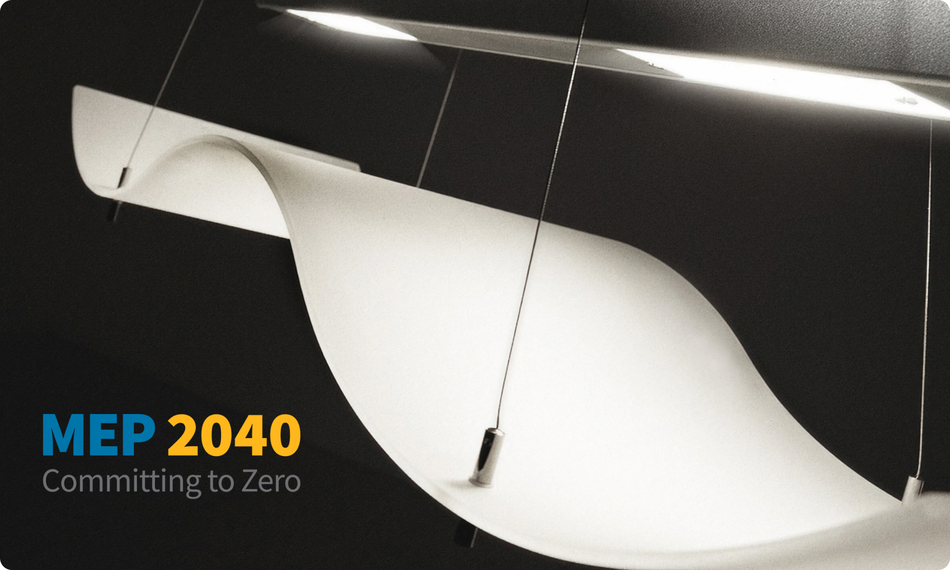Mechanical, electrical, and plumbing (MEP) systems are often the most complex, costly, and carbon-intensive part of a building — yet they've historically been largely absent from most life-cycle carbon assessments. Now that’s changing.
In April 2025, MEP 2040 and the Carbon Leadership Forum published The Beginner’s Guide to MEP Embodied Carbon, a comprehensive new resource designed to help engineers, sustainability professionals, and project teams account for the full carbon impact of mechanical, electrical, and plumbing systems. The guide fills a critical knowledge gap — and sets a new standard for how embodied carbon is measured and managed across the full life cycle of building systems.

MEP systems: a carbon blind spot
MEP systems are responsible for more than just operational emissions. They also include significant embodied carbon from materials (metals, plastics, insulation), manufacturing, transportation, construction waste, maintenance, and end-of-life. Add refrigerant leakage and equipment replacement into the mix, and the carbon footprint becomes even larger — and harder to track without the right methodology.
Until recently, most embodied carbon assessments excluded MEP altogether, or treated it as a placeholder percentage. The few LCA tools that do include MEP often lack the data granularity or life cycle coverage needed to fully assess these systems.
The result? MEP carbon is undercounted, misunderstood, and rarely reduced.
The guide: A roadmap for measuring and reducing MEP carbon
The Beginner’s Guide to MEP Embodied Carbon is the first industry-wide framework to address the lack of carbon data for MEP systems. It walks readers through how to:
- Conduct quantity takeoffs for MEP systems (piping, ductwork, wiring, equipment)
- Model life cycle emissions from A1 (material extraction) to C4 (disposal), including refrigerant leaks (B1), maintenance (B2–B3), and equipment replacements (B4)
- Apply real-world emission factors using environmental product declarations (EPDs) and LCA databases
- Analyze a full building case study to see the method in action
- Explore decarbonization strategies tailored to each system type
Crucially, the guide aligns with frameworks like ASHRAE 240P and RICS Whole Life Carbon Assessment, ensuring compatibility with emerging codes and certifications. It’s not just a research paper — it’s a practical playbook.
The MEP 2040 Challenge: a movement to radically reduce total carbon emissions associated with building systems through collective action
What the data shows: MEP contributes the majority of a building’s carbon footprint
The guide includes a detailed case study of Wymer Hall, a new academic building at the University of Illinois Urbana-Champaign. Using a full life-cycle assessment and One Click LCA’s MEP Carbon Tool, the team found:
- MEP systems contributed 27% of the building’s embodied carbon from materials and manufacturing alone (A1–A3)
- When refrigerants, maintenance, and equipment replacements were included, that share rose to 53% (A–C)
- When operational energy and water were added, MEP systems accounted for 73% of the total whole life carbon emissions
In other words, MEP systems had a greater carbon impact than the structure and enclosure combined — by a wide margin.
This finding isn’t an outlier. It reflects how energy systems, large-scale equipment, and distributed components shape a building’s emissions profile over decades. The more efficient our buildings become, the more MEP stands out.
How One Click LCA supports MEP Engineers
The guide’s featured case study, Wymer Hall, was modeled using One Click LCA’s MEP Carbon Tool, one of the few platforms identified as capable of implementing the full methodology across all relevant life-cycle stages — including often-overlooked elements like refrigerant leakage, equipment replacements, and end-of-life impacts
For engineers looking to apply the guide’s methods, the MEP Carbon Tool provides:
- Support for all key life cycle stages (A1–C4)
- Integration with building information modeling (BIM) tools for quantity takeoffs
- Flexible data inputs for materials, refrigerants, replacements, and maintenance
- Access to EPD data and generic GWP values across MEP categories
- System-by-system breakdowns to identify carbon hotspots
Developed in close collaboration with MEP 2040, One Click LCA’s MEP Carbon tool has been shaped to align with evolving industry best practices, providing a practical means to apply the guide’s methodology on real-world projects.
A shared mission with MEP 2040
One Click LCA is proud to partner with MEP 2040 in advancing decarbonization through data, education, and software tools. Together, we support the movement’s goal: to eliminate embodied carbon from MEP systems by 2040 and operational carbon by 2030.
As part of this partnership, all MEP 2040 signatories receive a six-month complimentary license to the MEP Carbon Tool. Signatories can also access training and support from the MEP 2040 working group, as well as free training in the One Click LCA Academy
Access the MEP Carbon tool: Become an MEP 2040 signatory and gain access to One Click LCA’s MEP Carbon Tool
Why MEP carbon matters now
Policy is shifting. Clients are asking for more transparency. Whole life carbon requirements are coming into force. And increasingly, carbon isn’t just about structure — it’s about systems.
That’s why this guide matters.
It gives MEP engineers a language, a framework, and a methodology to show the carbon impact of their work. It empowers teams to identify meaningful trade-offs, improve system design, and reduce emissions at scale.
And it sets the expectation that future-ready projects — from hospitals to data centers — must account for the systems behind the scenes.
Getting started
If you're an MEP engineer, this guide is a must-read. It offers the tools to move from estimation to measurement, from awareness to action.
You can download The Beginner’s Guide to MEP Embodied Carbon for free, and if you're a signatory of MEP 2040, you can activate your complimentary access to One Click LCA’s MEP Carbon Tool to start applying the methodology right away.
Carbon Experts Newsletter
Industry news & insights — straight to your inbox
Want to learn more?
Laura Drury • Apr 23 2025
Justyna Michalik-Minken • Apr 14 2025
Melina Zacharia • Apr 11 2025
